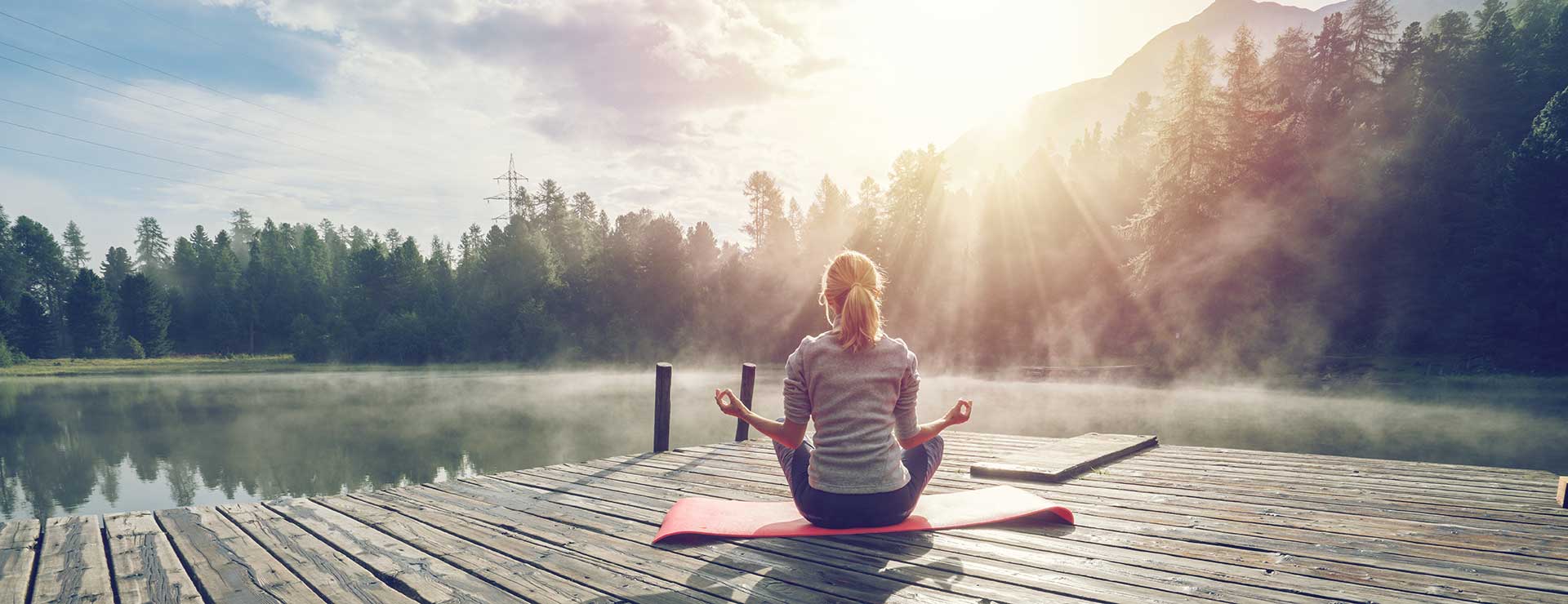These 9 poses are a complete yoga workout. Move slowly through each pose, remembering to breathe as you move. Pause after any pose you find challenging, especially if you are short of breath, and start again when your breathing returns to normal. The idea is to hold each pose for a few, slow breaths before moving on to the next one.
Child's Pose

Child's Pose
This should be your go-to pose whenever you need to rest for a moment during a yoga workout.
This calming pose is a good default pause position. You can use child’s pose to rest and refocus before continuing to your next pose. It gently stretches your lower back, hips, thighs, knees and ankles and relaxes your spine, shoulders and neck.
Do it: When you want to get a nice gentle stretch through your neck spine and hips.
Skip it: If you have knee injuries or ankle problems. Avoid also if you have high blood pressure or are pregnant.
Modify: You can rest your head on a cushion or block. You can place a rolled towel under your ankles if they are uncomfortable.
Be mindful: Focus on relaxing the muscles of the spine and lower back as you breathe.
Downward-Facing Dog

Downward-Facing Dog
This is one of the most common yoga poses.
Downward-facing dog strengthens the arms, shoulders and back while stretching the hamstrings, calves and arches of your feet. It can also help relieve back pain.
Do it: To help relieve back pain.
Skip it: This pose is not recommended if you have carpal tunnel syndrome or other wrist problems, have high blood pressure or are in the late stages of pregnancy.
Modify: You can do the pose with your elbows on the ground, which takes the weight off your wrists. You can also use blocks under your hands, which may feel more comfortable.
Be mindful: Focus on distributing the weight evenly through your palms and lifting your hips up and back, away from your shoulders.
Plank Pose

Plank Pose
This common pose can build strength in the core, shoulders, arms and legs.
A commonly seen exercise, plank helps build strength in the core, shoulders, arms and legs.
Do it: Plank pose is good if you are looking to tone your abs and build strength in your upper body.
Skip it: Avoid plank pose if you suffer from carpal tunnel syndrome. It can be hard on your wrists. You might also skip it or modify if you have low back pain.
Modify: You can modify it by placing your knees on the floor.
Be mindful: As you do a plank, imagine the back of your neck and spine lengthening.
Four-Limbed Staff Pose

Four-Limbed Staff Pose
This pose builds strength in the arms, shoulders, wrists and back and helps tone the abdomen.
This push-up variation follows plank pose in a common yoga sequence known as the sun salutation. It is a good pose to learn if you want to eventually work on more advanced poses, such as arm balances or inversions.
Do it: Like plank, this pose strengthens arms and wrists and tones the abdomen.
Skip it: If you have carpal tunnel syndrome, lower back pain, a shoulder injury or are pregnant.
Modify: It’s a good idea for beginners to modify the pose by keeping your knees on the floor.
Be mindful: Press your palms evenly into the floor and lift your shoulders away from the floor as you hold this pose.
Cobra Pose

Cobra Pose
One of the simpler back-bending poses.
This back-bending pose can help strengthen the back muscles, increase spinal flexibility and stretches the chest, shoulders and abdomen.
Do it: This post is great for strengthening the back.
Skip it: If you have arthritis in your spine or neck, a low-back injury or carpal tunnel syndrome.
Modify: Just lift up a few inches, and don’t try to straighten your arms.
Be mindful: Try to keep your navel drawing up away from the floor as you hold this pose.
Triangle Pose

Triangle Pose
This pose can be found in many yoga sequences.
Triangle, which is a part of many yoga sequences helps build strength in the legs and stretches the hips, spine, chest, shoulders, groins, hamstrings and calves. It can also help increase mobility in the hips and neck.
Do it: This pose is great for building strength and endurance.
Skip it: Avoid this pose if you have a headache or low blood pressure.
Modify: If you have high blood pressure, turn your head to gaze downward in the final pose. If you have neck problems, don’t turn your head to look upward; look straight ahead and keep both sides of the neck long.
Be mindful: Keep lifting your raised arm toward the ceiling. It helps keep the pose buoyant.
Seated Half-Spinal Twist Pose

Seated Half-Spinal Twist Pose
Want to relieve the tension in your back? Try this twisting pose.
This twisting pose can increase the flexibility in your back, while stretching the shoulders, hips and chest. It can also help relieve tension in the middle of your back.
Do it: To release tight muscles around the shoulders and upper and lower back.
Skip it: If you have a back injury.
Modify: If bending your right knee is uncomfortable, keep it straight out in front of you.
Be mindful: Lift your torso with each inhale, and twist as you exhale.
Bridge Pose

Seated Half-Spinal Twist Pose
Want to relieve the tension in your back? Try this twisting pose.
This is a back-bending pose that stretches the muscles of the chest, back and neck. It also builds strength in the back and hamstring muscles.
Do it: If you sit most of the day, this pose will help you open your upper chest.
Skip it: Avoid this pose if you have a neck injury.
Modify: Place a block between your thighs to help keep the legs and feet in proper alignment. Or you can place a block under your pelvis if your lower back is bothering you.
Be mindful:While holding this pose, try to keep your chest lifted and your sternum toward your chin.
Tree Pose

Tree Pose
This balancing pose is one of the most recognized poses in modern yoga.
Beyond helping improve your balance, it can also strengthen your core, ankles, calves, thighs and spine.
Do it: Great for working on your balance and posture.
Skip it: You many want to skip this pose if you have low blood pressure or any medical conditions that affect your balance.
Modify: Place one of your hands on a wall for support.
Be mindful: Focus on your breath in and out as you hold this pose.




 When we are stressed and anxious, our bodies release stress hormones like cortisol and adrenaline which can actually compromise our immune system.Meditation is the remedy for stress because it boosts our immune system with hormones that
are also internal counter-measures against stress.
When we are stressed and anxious, our bodies release stress hormones like cortisol and adrenaline which can actually compromise our immune system.Meditation is the remedy for stress because it boosts our immune system with hormones that
are also internal counter-measures against stress.

